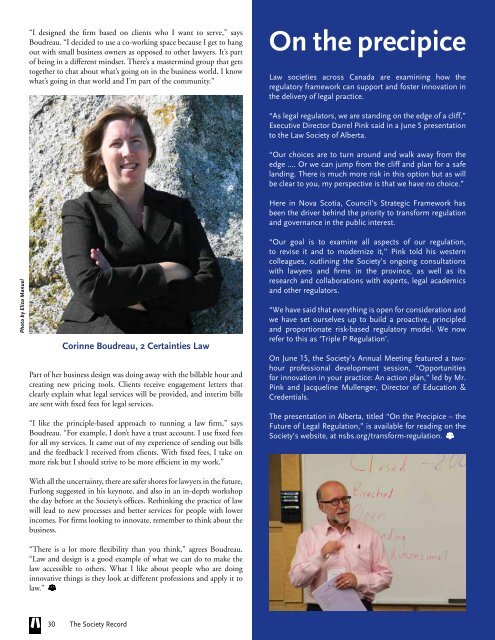11eApYW
11eApYW
11eApYW
Create successful ePaper yourself
Turn your PDF publications into a flip-book with our unique Google optimized e-Paper software.
“I designed the firm based on clients who I want to serve,” says<br />
Boudreau. “I decided to use a co-working space because I get to hang<br />
out with small business owners as opposed to other lawyers. It’s part<br />
of being in a different mindset. There’s a mastermind group that gets<br />
together to chat about what’s going on in the business world. I know<br />
what’s going in that world and I’m part of the community.”<br />
On the precipice<br />
Law societies across Canada are examining how the<br />
regulatory framework can support and foster innovation in<br />
the delivery of legal practice.<br />
Photo by Eliza Manuel<br />
Corinne Boudreau, 2 Certainties Law<br />
Part of her business design was doing away with the billable hour and<br />
creating new pricing tools. Clients receive engagement letters that<br />
clearly explain what legal services will be provided, and interim bills<br />
are sent with fixed fees for legal services.<br />
“I like the principle-based approach to running a law firm,” says<br />
Boudreau. “For example, I don’t have a trust account. I use fixed fees<br />
for all my services. It came out of my experience of sending out bills<br />
and the feedback I received from clients. With fixed fees, I take on<br />
more risk but I should strive to be more efficient in my work.”<br />
With all the uncertainty, there are safer shores for lawyers in the future,<br />
Furlong suggested in his keynote, and also in an in-depth workshop<br />
the day before at the Society’s offices. Rethinking the practice of law<br />
will lead to new processes and better services for people with lower<br />
incomes. For firms looking to innovate, remember to think about the<br />
business.<br />
“There is a lot more flexibility than you think,” agrees Boudreau.<br />
“Law and design is a good example of what we can do to make the<br />
law accessible to others. What I like about people who are doing<br />
innovative things is they look at different professions and apply it to<br />
law.”<br />
“As legal regulators, we are standing on the edge of a cliff,”<br />
Executive Director Darrel Pink said in a June 5 presentation<br />
to the Law Society of Alberta.<br />
“Our choices are to turn around and walk away from the<br />
edge .... Or we can jump from the cliff and plan for a safe<br />
landing. There is much more risk in this option but as will<br />
be clear to you, my perspective is that we have no choice.”<br />
Here in Nova Scotia, Council’s Strategic Framework has<br />
been the driver behind the priority to transform regulation<br />
and governance in the public interest.<br />
“Our goal is to examine all aspects of our regulation,<br />
to revise it and to modernize it,” Pink told his western<br />
colleagues, outlining the Society’s ongoing consultations<br />
with lawyers and firms in the province, as well as its<br />
research and collaborations with experts, legal academics<br />
and other regulators.<br />
“We have said that everything is open for consideration and<br />
we have set ourselves up to build a proactive, principled<br />
and proportionate risk-based regulatory model. We now<br />
refer to this as ‘Triple P Regulation’.<br />
On June 15, the Society’s Annual Meeting featured a twohour<br />
professional development session, “Opportunities<br />
for innovation in your practice: An action plan,” led by Mr.<br />
Pink and Jacqueline Mullenger, Director of Education &<br />
Credentials.<br />
The presentation in Alberta, titled “On the Precipice – the<br />
Future of Legal Regulation,” is available for reading on the<br />
Society’s website, at nsbs.org/transform-regulation.<br />
30<br />
The Society Record


